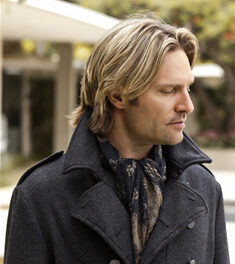The recent Paperhand Puppet Intervention production The City of Frogs, performed at the NC Museum of Art in Raleigh, held its share of longuers but most of it was splendid and much of it was magic of the kind that — a paradox of live theatre — happens only when we can see the strings being pulled.
Paperhand’s approach embraces forms that extend well beyond what we may conjure when we think of puppetry, yet celebrate indigenous traditions. This is not to slander the charm of a Burr Tillstrom or to eschew the rigors of marionette performance. If any single creative force were recalled here it would be Jim Henson, who moved the puppet from behind the box and literally gave it wings.
In The City of Frogs, buildings moved and swayed. Huge, troll-like heads, some of them elongated, were held on normal-sized bodies. Performers walked on stilts and sported extended, artificial necks. Dancers in green costumes, amphibian heads attached, performed a frog ballet. Many of the puppeteers appeared in full view, wearing black, which — in the manner of Japanese theatre — rendered them “invisible,” adding immeasurably to the man-made charm of the show. The Pinocchio-like Puppet Boy at the heart of the tale was walked and operated by a pair of puppeteers in plain view. After a mishap, the Puppet Boy’s head was attached to various, ill-fitting bodies: a birdcage with dogs’ legs, a length of insulated hose that undulates like a snake. A crucial river was conceived as a face with enormous, sentient eyes; in flow it was not unlike the body and tail of a Chinese dragon, another form of puppetry. At the climax, a massive, llama-like creature with a human/demonic head and horns appeared, a deus ex machina that did not so much frighten as delight.
As written and imaginatively directed by Jan Burger with Donovan Zimmerman, The City of Frogs is a fable, with digressions. The Puppet Boy, brought to life, searches for an old woman’s heart and is, in the manner of fables, given a single day in which to complete the task. During this quest, he is told a traditional Golem story concerning a rabbi “who listened very well.” This proves, again in the fashion of the genre, less incidental than it first appears. The ecological underpinning was central but never heavy-handed or didactic, as is so often the case with metaphor for children.
Indeed, to paraphrase McLuhann, the media were the message: Many of the puppets were textured to reflect the colors of nature; the cut-out inhabitants of the rabbi’s village, for example, were hued in shades of leafy green while the city built over the river which was central to the tale was of an uneasy, somehow polluted, brown.
The instrumental score was genuinely pleasing and splendidly performed, although the occasional songs seldom rose to a level above the functional. A grotesque junkman had a singing and speaking voice not unlike that of Dr. John, authentic Klezmer strains accompanied the Golem story, and the ethereal sound of the river’s wordless song was exceptionally well designed.
Although never less than graceful, much of the company’s mass movement had the feeling of filler, adding only texture. In moderation, a plus. In excess, tiresome. Similarly, the frequent tableaux, although applauded by the audience, seemed designed to show off the artistry, and under- rather than overwhelmed. The City of Frogs was so often a marvel it didn’t need to over-impress.











